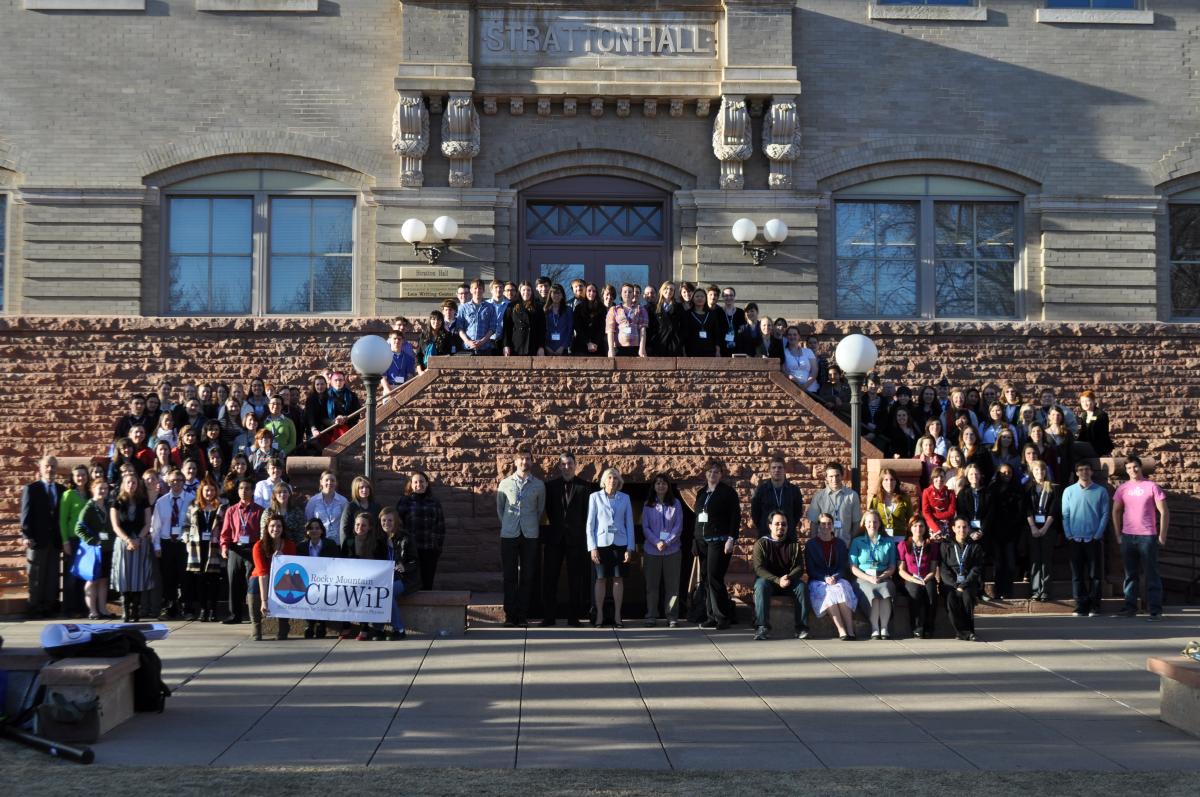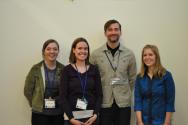Conferences for Undergraduate Women in Physics
January 18, 2013 to June 20, 2013
Golden, Colorado
Meeting host: By:Nicole Johnson
SPS Chapter:
This January marked the eighth annual Conference for Undergraduate Women in Physics (CUWiP). Started at the University of California eight years ago, this series of conferences has grown to include six simultaneous sites and over five hundred attendees from all over the country. Now under the guidance of the American Physical Society, CUWiP’s mission is to encourage undergraduate women in physics by giving them the opportunity to experience a professional conference, gain information regarding the various career options for physicists, and provide networking sessions to build a support network with accomplished female physicists in the field.
I attended and helped plan the Rocky Mountain site of this year’s CUWiP. Along with three others from my home institution of the Colorado School of Mines (CSM), I went to the Stanford CUWiP last January. While the advice was helpful in many ways, we couldn’t help but wonder “Why aren’t the men here to listen to this too”? We came back to CSM with that in mind, and with the support of the physics department and our chapter of the Society of Physics Students, decided to host a CUWiP at CSM.
Over 130 undergraduate students from seventeen different states and thirty‐four institutions attended the Rocky Mountain Region CUWiP. With the exception of a handful of graduate students and professors, every attendee was an undergraduate student with approximately 60% juniors/seniors and 40% sophomores/freshmen. A little less than ten percent had attended a CUWiP before and approximately one fifth of the conference attendees were male. What turned out to be a pleasant surprise was the fact that the males wrote some of the best personal statements and genuinely cared about promoting collaboration between both genders in the sciences.
Conference events kicked off with laboratory tours to one of three local labs: the National Renewable Energy Laboratory (NREL), the National Oceanic and Atmospheric Administration (NOAA), and the US Geological Survey (USGS) building on the CSM campus. At NREL participants learned about how every building at the lab is energy efficient and uses the natural resources around it for heating, cooling and natural light. At NOAA attendees attended presentations about space weather, solar activity, global warming and local weather prediction. At the USGS attendees learned how geological equipment can measure the intensity and locations of earthquakes and even got to see raw data from a recent earthquake.
The participants came together later that night for a Welcome Banquet at the Marriott Hotel where they heard talks from Dr. Kate Kirby, executive officer of the American Physical Society, and Dr. Cynthia Norrgran, a professor at CSM. Dr. Kirby gave an overview of her life’s journey, professional and personal, as well as an overview of her research interests in molecular processes in astrophysics. She emphasized that “Yes, you can have a career and a life too” with the recommendation that everyone, especially women, give themselves perspective. “Be generous to yourself….not a lot of negative talk...a career is long and recognize that it will have localized peaks and troughs,” she told us. Dr. Norrgran’s talk focused more on her research on physics and the brain. A brain surgeon by trade, Dr. Norrgran uses physics to combine technology and brain surgery to improve the understanding and treatment of brain ailments. When asked for advice on how much schooling to get she said, “In the long run money is cheap, your time and expertise is not. You cannot stop at a B.S., a Masters is a minimum”.
Saturday’s events started bright and early for the participants at CSM’s campus. The first lecture, given by Dr. Patrick Kohl from CSM, discussed the importance of changing the current curriculum model in physics education. Along with fellow colleagues, he developed and implemented a hybrid lecture‐studio model in the introductory physics classes. In this model students attend lecture twice a week and studio for two hours twice a week. In studio, students are assigned to groups of three and work through physics problems on the computer with the occasional experimental set‐up where they can collect data. By allowing students to sit down and solve problems, Dr. Kohl argues that students retain and learn the material through doing rather than memorization.
Dr. Robert Knecht and four other people from industry jobs then participated in a panel discussion about how a physics degree can be applied to industry jobs. After a brief break, participants went to one of three workshops on communicating physics ideas, applying for graduate school, and how to
stand out when applying for a job with your physics degree.
Up until this point, all the CUWiP sites were hosting activities independently. At 12:30 Colorado time, the sites came together to listen to the simulcast of the keynote speaker, Dr. Margaret Murnane, who spoke from the Colorado School of Mines site. On top of being a well‐accomplished researcher in the field of laser physics, for which she was appointed Chairman of the President’s Committee for the National Medal of Science in 2011, she is also an active mentor internationally for recruiting women into physics. During her talk, she emphasized the importance of all scientists working and collaborating to meet the problems of the twenty‐first century. She gave the example of a project she and her husband collaborated on with other groups over the past twenty years and said that “without that collaboration, it would not have been feasible to accomplish what they did as quickly as they did”. Murnane noted that with the younger generation growing up with the internet and having instantaneous access to all kinds of information, collaboration will not only be easier but will become more prevalent among international researchers. “My grad students are able to analyze more data points in a single day than I did in my entire PhD,” she said.
After the keynote, about a dozen undergraduates presented posters showcasing their research. Topics ranged from film crystalline‐silicon solar cells (Jennifer Buechler, Colorado School of Mines) to the structure of phase space for a symmetric case of the N body problem (Emma Hogan, Brigham Young University).
After taking a group photo, the group reconvened for a talk by Dr. Meg Urry on black holes. Her research focuses on accreting supermassive black holes and the co‐evolution of these with normal galaxies. In addition, she is active in involving women in the field of astrophysics, turning the tide for women in the field with the creation of the Baltimore Charter for Women in Astronomy. Afterwards participants had the opportunity to talk with representatives from a wide range of professional societies and state educational institutions such as the American Association of Physics Teachers (AAPT), University of Colorado at Boulder, the Colorado School of Mines physics department and Colorado State University.
Saturday concluded with a networking banquet at the Marriott Hotel where students had an opportunity to talk further with the various representatives. Dr. Case from JILA, part of the National Institute of Standards and Technology, emphasized that it’s ok to not know exactly what you want straight out of high school or college. Other tables discussed the importance of research experience and the transition from being an undergraduate to a graduate student or an employee in industry.
Sunday began with a lecture by Dr. Roel Sneider from CSM. On top of his research on landslides and volcanoes, he has worked to develop a graduate student research ethics curriculum across CSM. Other Saturday morning events included a second set of workshops, of which one of the most popular was Applying to Research Experience for Undergraduates (REUs), which I led. Along with two other female physics undergraduates who participated in REUs last summer, I answered questions on subjects ranging from how to make an application stand out to what a typical day is like to what kind of responsibilities you have during an REU. After a brief break, participants reconvened for a panel moderated by engineering physics senior Ariel Bridgeman. In this panel a handful of graduate students conversed about the obstacles and responsibilities of graduate students as well as gave advice for undergraduates who may be considering graduate school.
During lunch about a dozen graduate students presented their research during a poster session. The topics were as varied as those in the undergraduate poster session. Afterwards, participants had the chance to tour CSM and some of the labs, including Dr. Jeff Squier’s laser lab, Dr. Brian Gorman’s atom probe, Dr. Patrick Kohl’s studio environment and Dr. Reuben Collins’ microelectronics processing lab. The final talk of the conference was given by Dr. Deborah Jin from the University of Colorado at Boulder. Her research focuses on ultracold trapped atoms where quantum effects heavily dictate the atoms’ behavior. Dr. Alex Flournoy, faculty adviser for the executive student committee who planned the conference, gave a few closing remarks about the mission of CUWiP and steps students could take if they were excited about bringing the conference to their institution next year. Before coming to the conference, several attendees said that they felt as if women were not always taken seriously as physics students and are not pushed as much academically as their male peers. In the words of attendee Marina Bradaric, women are occasionally told, “‘Aw it’s ok, keep practicing…whereas if a male makes a mistake the professor would get harshly on his case to improve his potential”. After attending the conference, several participants felt better prepared for a post‐undergraduate career, whether in academia or industry. Others had a better understanding of how increasing women’s involvement, and therefore diversity, in physics is not only important but quite attainable in today’s world. More importantly, students enjoyed getting to know other physics students and professionals from all over the country, realizing that “we are not alone in our passion and drive for physics and its integral part in our lives,” as stated by attendee Rachel Smullen.
Areas of Alignment: Career Resources: Scientific Categories:

